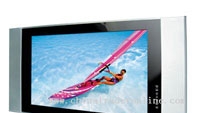Gas for flat-screen TV manufacturing accelerating global warming

Nitrogen trifluoride (NF3), a gas used in the making of flat-screen LCD televisions, is being blamed by environmental scientists for damaging the atmosphere and accelerating global warming. The gas, widely used in the manufacture of semiconductors and LCD panels, is estimated to be 17,000 times as powerful as carbon dioxide.
NF3 is not covered by the Kyoto protocol because it was only produced in tiny amounts when the treaty was signed in 1997. Levels of this gas in the atmosphere have not been measured, but scientists say it is a concern and are calling for it to be included in any future emissions-cutting agreement.
“New Scientist” magazine has published an article on the issue by Michael Prather, a professor at the University of California. The gas, Prather told ABC, needs to be measured.
“One of my titles for this paper was ‘Going Below Kyoto’s Radar.’ It’s the kind of gas that’s made in huge amounts,” he said. “Not only is it not in the Kyoto Treaty but you don’t even have to report it. That’s the part that worries me.”
Prather estimates 4000 tons of NF3 will be produced in 2008, and that number is likely to double next year. “We don’t know what’s emitted, but what they’re producing every year dwarfs these giant coal-fired power plants that are like the biggest in the world,” he said. “And it dwarfs two of the Kyoto gases. So the real question we don’t know is how much is escaping and getting out.”
Dr. Paul Fraser, chief research scientist at the CSIRO’s marine and atmospheric research center, told ABC that without measuring the quantity of NF3 in the atmosphere it is unclear what impact it will have on the climate.
Get the TV Tech Newsletter
The professional video industry's #1 source for news, trends and product and tech information. Sign up below.
